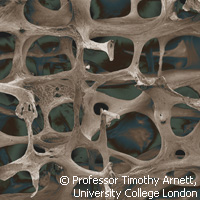New treatments for osteoporosis patients in the pipeline
Findings from EU-funded research into the mechanisms behind the beneficial effects of exercise on bones could lead to new treatments for osteoporosis sufferers. The research was carried out as part of the ATPBone ('Fighting osteoporosis by blocking nucleotides: purinergic signalling in bone formation and homeostasis') project, which received nearly EUR 3 million of funding under the 'Health' Theme of the European Commission's Seventh Framework Programme (FP7). The largest European bone biology and osteoporosis research project ever carried out within its field, ATPBone ran from 2008 to 2010 and brought together scientists from Belgium, Denmark, Italy, the Netherlands and the United Kingdom. The pan-European team of scientists investigated how bone tissue is maintained and how specific biochemical signal molecules regulate the degradation of bone as well as the formation of new bone. 'It is well-established that exercise prevents osteoporosis - after the ATPBone project we also know why,' says Professor Peter Schwarz from the Copenhagen University Hospital Glostrup in Denmark, the coordinating institution. For patients, the onset of osteoporosis is characterised by excessive bone loss and frequent bone fractures. Researchers estimate that in 2000, 3.8 million osteoporotic fractures occurred in Europe. Aside from bone fractures, osteoporosis can also be diagnosed by measuring the mineral content in bones by performing a 'dual energy absorptiometry' scan. This can determine whether the patient has the condition or suffers from low bone mass that could develop into osteoporosis later in life. Although treatment can restore some of the lost bone mass, osteoporosis is largely an incurable condition, and is more common in women than men. One in five elderly people with a hip fracture die within a year of developing the fracture. The ATPBone project scientists were able to demonstrate that physical activity and other stimuli to the bones induce the release of the biochemical compound ATP. This biochemical compound regulates bone turnover through action on the so-called purinergic receptors, which have been shown to be present on bone cells. In addition to this finding, the scientists discovered that treating bone cells with parathyroid hormone, which is produced in the human body and is also used by doctors for treatment of severe osteoporosis, induces an increased release of ATP upon mechanical stimulation and that ATP and parathyroid hormone interact on the receptors. This means that the locally acting purinergic signalling system could interact with hormone systems in the body. Niklas Rye Jørgensen, coordinator of the ATPBone project and researcher from Glostrup Hospital and Copenhagen University says: 'Through ATPBone we have shown that the purinergic signalling system has profound effects on bone turnover and that it is a potent system through which we can potentially prevent or even treat osteoporosis.' Jørgensen also outlines that as well as being music to patients' ears, their findings have crucial economic implications for society. In terms of the strain on European health services, direct medical costs related to osteoporotic fractures are estimated to be in the region of EUR 36 billion a year, so any new treatments would help reduce this financial burden. Ultimately, the scientists hope their findings will help meet Europe's requirements for the development of new anti-osteoporotic drugs, and with incidences of osteoporosis only expected to rise further over the coming decades amid an ageing European population, this need has never been greater.For more information, please visit:ATPBONE:http://www.atpbone.org/Copenhagen University Hospital Glostrup:http://www.glostruphospital.dk/menu/
Countries
Belgium, Denmark, Italy, Netherlands, United Kingdom



